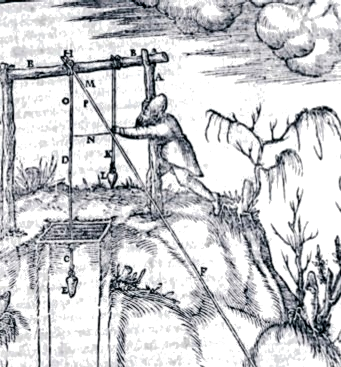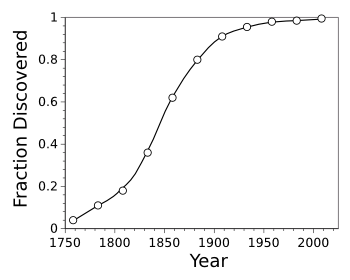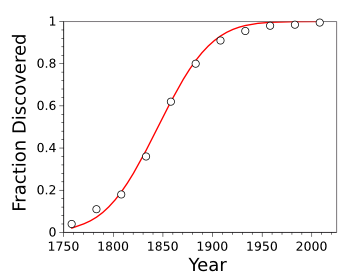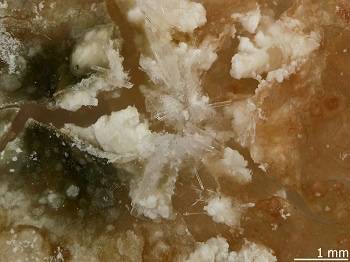Earth's Mineral Wealth
October 19, 2015
Children enjoy collecting
rocks. I collected rocks when I was young, as did my children when they were young, and I have one
colleague who still has an interest in
mineralogy. I learned the basics of
geology at a very early age from several of my "
Golden Books." That's how I learned to distinguish
sedimentary from
igneous from
metamorphic, but I was always fuzzy about what a
conglomerate was all about.

Marble, which is metamorphosed limestone, was a prized sculpting material.
The Roman poet, Horace, made reference to the whiteness of Parian marble in one of his Odes.[1]
Detail of a marble statue of Jupiter from a Capitoline Triad located in Palestrina.
(Portion of a Wikimedia Commons image.)
Rocks contain
minerals,
crystallites of simple
chemical compounds. Since we live in an
oxidizing environment, these minerals are usually
oxides,
sulfides, and
sulphates. A few of the more common minerals are listed in the table below.
Humans have
mined the
Earth from
prehistoric times looking for useful materials such as
flint, for
weapons, and
hematite as a
pigment. Thereafter, the more easily
smelted metals, such as
gold,
silver, and
copper, were mined for
jewelry,
cookware, weapons and
armor. As I wrote in a
previous article (Antimony Nanocrystals, April 7, 2014), the
chemical extraction of metals was well developed quite a few
centuries ago. In his 1556 book, "
De Re Metallica,"
Georgius Agricola gave the following method for extraction of silver from gold by means of
antimony (stibium).[2]
Silver is also parted from gold by means of stibium. If in a bes of gold there are seven, or six, or five double sextulae of silver, then three parts of stibium are added to one part of gold; but in order that the stibium should not consume the gold, it is melted with copper in a red hot earthen crucible.[2-3]

An illustration of a mine shaft from De Re Metallica (1556) by Georgius Agricola.
Agricola has been called the "Father of mineralogy."
(Portion of a Wikimedia Commons image.)
Humans have been poking around in the
dirt for
millennia, and we've discovered quite a few minerals; but, have we discovered
all of Earth's minerals? While it might seem that there should always be another mineral buried somewhere just waiting to be discovered, it's actually possible to estimate how many undiscovered minerals there may be. How could something like this be done?
As an example, let's look at the number of
bird species. The following graph shows the progress in finding new species of birds as a function of time. To put these
data into perspective,
Charles Darwin's discovery of
many new species of finches on the
second voyage of the HMS Beagle happened in 1837. As an
educated guess, we can conclude that nearly every bird species has been discovered.

Fraction of total discovered bird species as a function of year.
(From data in Ref. 4, graphed using Gnumeric.)[4)]
The curve through the points in the above graph resembles a curve called the
error function. This function, which is related to the
normal distribution, is defined as follows:

As you can see, the error function is not that easy to compute. Fortunately, most
spreadsheet programs will calculate values of the error function, typically by calling
erf(), so that's not a problem. Spreadsheets and other application programs that use the error function compute it as a
series expansion, as follows:

In this expansion, the
denominators of the
fractions are given by
n!(2n + 1). We can see how well an error function fits the bird species data in the graph below. In this case, the fitted function is
(1 + erf((Year-1845)/60))/2, and we see how knowledge of where we are on the curve tells us how many species are left to be discovered.

Fraction of total discovered bird species as a function of year and an error function fit.
(Graphed using Gnumeric)
A team of mineralogists from the
Carnegie Institution for Science (Washington, DC), the
University of Arizona (Tucson, Arizona), and the
University of Maine (Orono, Maine) took a different approach to finding the number of undiscovered minerals.[5-6] As explained by team leader,
Robert Hazen from the Carnegie Institution, "Minerals follow the same kind of
frequency of distribution as
words in a
book," so the number of rare minerals can be estimated based on the distribution of common minerals.[6]
The
probability that a mineral type exists at ten or fewer locations is about 65%, while that probability drops to 22% for minerals existing in just one place. Most mineral types are rare, being found in five or fewer places.[6] The
research team found that the Earth contains 4,831 known minerals, as sampled from 135,415 locations, and their analysis indicates that there are perhaps 1,563 minerals yet to be discovered.[5-6]

Hazenite, a mineral named after Robert Hazen, is an example of a rare mineral. It's found in only one place, Mono Lake, California.
(Carnegie Institution photo by Hexiong Yang.)
As mentioned earlier in this article, Earth's minerals reflect its oxidizing environment. That oxidizing environment was established by
photosynthetic organisms during the
Great Oxygenation Event about 2.3 billion years ago. About two-thirds of Earth's minerals would not exist if life did not
evolve on Earth.[7-8] This finding indicates that the geology of
exoplanets would be quite different from that of Earth.
References:
- Urit me Glycerae nitor/Splendentis Pario marmore purius. (I burn when I see Glycera, purer than Parian marble) Quintus Horatius Flaccus, Ode XIX, from "The Odes of Horace," book 1, Engl. verse tr. by J.J. Lonsdale (Richard Bentley and Son, London, 1879), p. 50 (via Google Books).
- Herbert Clark Hoover and Lou Henry Hoover, translators, "De Re Metallica" by Georgius Agricola, Dover Publications, (New York, 1950), p. 452.
- Georg Agricola, "De re metallica," Hieron Frobenium et Nicolaum Episcopium, (Basil, 1556), in Latin, via the Internet Archive.
- Bird species discovery odds and ends, Slybird Blog, December 14, 2010.
- Robert M. Hazen, Grethe Hystad, Robert T. Downs, Joshua Golden, Alex J. Pires, and Edward S. Grew, "Earth's “missing” minerals," American Mineralogist (In Press, June, 2015).
- Earth's mineralogy unique in the cosmos , Carnegie Institution Press Release, August 26, 2015.
- Robert M. Hazen, Dominic Papineau, Wouter Bleeker, Robert T. Downs, John M. Ferry, Timothy J. McCoy, Dimitri A. Sverjensky, and Hexiong Yang, "Mineral evolution," American Mineralogist, vol. 93 (November-December, 2008), pp. 1693–1720.
- Roberta Kwok, "How Life and Luck Changed Earth's Minerals," Quanta Magazine, August 11, 2015.
Permanent Link to this article
Linked Keywords: Child; Children; rock; colleague; mineralogy; geology; Golden Books; sedimentary; igneous; metamorphic; conglomerate; marble; metamorphose; limestone; sculpture; sculpting; material; Roman poet; Horace; whiteness; Paros; Parian marble; Odes; statue; Jupiter; Capitoline Triad; Palestrina; Wikimedia Commons; mineral; crystal; crystallite; chemical compound; oxide; oxidize; environment; sulfide; sulphate; quartz; corundum; magnetite; hematite; calcite; gypsum; galena; pyrite; plagioclase; human; mining; mine; Earth; prehistory; prehistoric times; flint; weapon; hematite; pigment; smelting; smelt; metal; gold; silver; copper; jewelry; cookware; armor; extractive metallurgy; chemical extraction of metal; century; De Re Metallica; Georgius Agricola; antimony; incandescence; clay; crucible; mineralogy; dirt; millennium; millennia; bird; species; data; Charles Darwin; Darwin's finches; second voyage of the HMS Beagle; educated guess; bird; species; function; Gnumeric; error function; normal distribution; spreadsheet program; series expansion; denominator; fraction; Carnegie Institution for Science (Washington, DC); University of Arizona (Tucson, Arizona); University of Maine (Orono, Maine); Robert Hazen; fFrequency distribution">frequency of distribution; word; book; probability; research; hazenite; Mono Lake, California; Hexiong Yang; photosynthesis; photosynthetic; organism; Great Oxygenation Event; evolution; exoplanet.